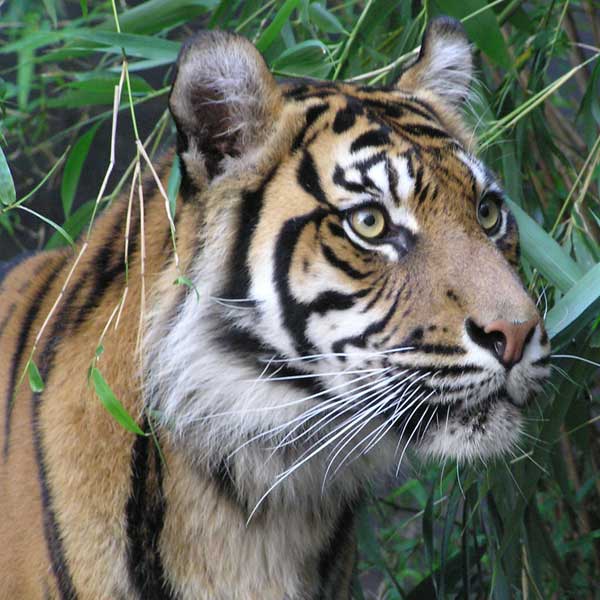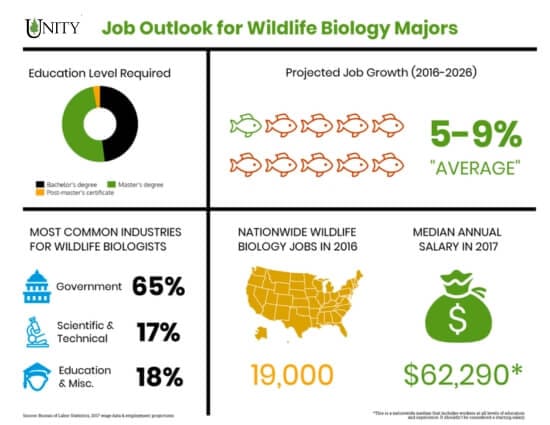
Not everyone is cut out for a career in wildlife biology. It’s true. Not everyone is willing to put in the hours of schooling and training it takes to understand myriad animal habitats, landscapes, and refuge systems that crisscross our country. Not everyone is willing to think beyond themselves and shoulder the burden of preserving natural habitats and protecting endangered species for generations to come.
But if you’re willing to put in the work, earning a wildlife biology degree can put you on the path toward pursuing your lifelong goal of helping animals survive and thrive.
That probably all sounds great. You’re probably nodding your head in agreement and convincing yourself now’s the time to go after your dream. But, you also might be asking yourself, “What can I do with a wildlife biology degree?” Don’t worry, it’s natural.
We dug into research from the U.S. Department of Labor (USDOL) and the U.S. Fish & Wildlife Service (USFWS) to help you navigate the path that makes the most sense for your future. To that end, we profiled a broad selection of job titles, daily tasks, necessary skills, and job outlook for those who choose to enter a marine biology program.
Wildlife Biology Careers for ‘Animal Lovers’
Our “animal lovers” jobs are perfect for those who have been passionate about helping animals from a young age. They’re hands-on learners who are compassionate, career-driven, and not afraid of a competitive field. They’re the ones who don’t shy away from a challenge and are naturally drawn to leadership roles.
Job titles you can expect to see
Once you earn a wildlife biology degree, you’ll have a chance to specialize in a certain field or species. Specialization can come from additional schooling—earning a master’s or doctoral degree—or via on-the-job training, but those hoping to move into one of the careers included here are expected to have knowledge, skills, and work experience in addition to a bachelor’s degree. Bottom line: You’re likely going to need advanced education but a bachelor’s degree is the best way to begin your journey.
Jobs in this category include (but aren’t limited to):
- Aquatic biologist
- Fish & wildlife biologist
- Conservation resources management biologist
- Fisheries biologist
- Habitat biologist
- Marine mammalogist
- Wildlife manager
- Zoologist
People in these roles spend their days studying the origins, behavior, diseases, genetics, and life processes of aquatic animals and other wildlife, according to the USDOL. They may collect and analyze biological data to determine the environmental effects of present and potential use of land and water habitats.
Other jobs that might resonate with animal-loving marine biology majors include veterinarian and animal trainer, but the education required, median pay, and job outlook varied too much to be included in our comparison.
Day-to-day tasks you’ll be asked to perform
Regardless of what position you hold, if you continue down the wildlife biology degree path and specialize in one of the areas listed above, your day-to-day tasks will vary but will likely include some or most of the following. According to USDOL, here are six of the most common tasks you’ll be asked to perform in the hands-on kind of career you’re seeking.
- Study animals in their natural habitats, assess the impacts of environment and industry, interpret findings, and recommend alternative operating conditions
- Organize and conduct experimental studies with live animals in controlled or natural surroundings
- Make recommendations on management systems and planning for aquatic wildlife populations and habitat
- Inform and respond to public regarding wildlife and conservation issues, such as plant identification, hunting ordinances, and nuisance wildlife
- Write reports, scientific papers, and journal articles, and present to schools, clubs, interest groups, and government programs
- Prepare collections of preserved specimens or microscopic slides for species identification and study of development or disease
For U.S. Forest Service wildlife biologist, Mariko Yamasaki, the variation in day-to-day tasks is what excites her the most about her job.
“Being out and observing the natural world. Being able to test hypotheses. Being up real early on a bird survey. It’s never the same twice,” Yamasaki says in an interview with Ecozine. “I also enjoy discovering something new—there’s nothing any more special than that. There’s a lot out there! The scale of things to observe and study is mind-boggling.”
Job outlook* for animal lovers
As of 2016, people in these jobs worked for government organizations, scientific or technical organizations, higher education, and a smattering of “other” organizations.
The job is one that will allow you to fill your days doing what you love, similar to careers in marine biology, the job market for would-be wildlife biologists is very competitive. Job growth is considered “average” through 2026, which means just 1,900 new jobs will become available in that timespan.

Knowledge you’ll need to acquire with a wildlife biology degree
Because wildlife biology degree-holders have wide and varied career options, it’s crucial to prepare yourself with a diverse foundation of coursework. Obviously, you’ll need to take classes in biology, but other schools of study can provide a knowledge base that will complement the work you’re already doing and set you up for future success in a competitive field.
Wildlife biology majors should consider additional coursework in these areas:
- English: The structure and content of the English language including the meaning and spelling of words, rules of composition, and grammar
- Mathematics: Arithmetic, algebra, geometry, calculus, statistics, and their applications
- Computers & Electronics: Circuit boards, processors, chips, electronic equipment, and computer hardware and software, including applications and programming
- Geography: Principles and methods for describing the features of land, sea, and air masses, including their physical characteristics, locations, interrelationships, and distribution of plant, animal, and human life.
- Customer Service: Customer needs assessments, meeting quality standards for services, and evaluation of customer satisfaction
- Education: Principles and methods for curriculum and training design, teaching and instruction for individuals and groups, and the measurement of training effects.
- Communications & media: Media production, communication, and dissemination techniques and methods—including alternative ways to inform and entertain via written, oral, and visual media.
The wide variety of knowledge areas may seem like overkill, but you’ll need a well-rounded education if you want to distinguish yourself in this highly competitive field.
“There’s an old stereotype that a wildlife biologist leads a solitary life studying nature. This simply isn’t true,” Yamasaki says. “It’s important to know how to work with people and how to understand and deal with a variety of viewpoints. There is rarely a day that I sit alone in my office.”
The bottom line
There are a multitude of resources online that will help you understand what it’s like to be a wildlife biologist. But, the common denominator in all of them is the passion with which the subjects of the videos and articles talk about the outdoors and their contribution to preserving them.
The field requires animal lovers who have a penchant for scientific exploration and, as such, is very competitive. The number of jobs projected to become available over the next eight years is quite small and will require your best effort—it will also require education beyond a bachelor’s degree. But you can do it, and we can help. Our on-campus wildlife biology community is set up to support you and make sure you succeed.
If you’re considering Unity Environmental University for your wildlife biology degree, here is what a day in the life of a wildlife biologist looks like.
*Source: U.S. Bureau of Labor Statistics 2017 wage data and 2016-2026 employment projections.
Photo credit: U.S. Fish & Wildlife Service, Pacific Southwest Region



